Study on Sulfide Ore Dust Dispersion and Dust Reduction Measures Based on Simulation
Abstract
:1. Introduction
2. Numerical Simulation Methods
2.1. Physical Model
2.2. Mesh Configuration
2.3. Theoretical Model
2.3.1. Theory of Gas–Solid Two-Phase Flow
- (1)
- Control Equations of Continuous Phase Turbulent Flow
- (2)
- Control equations of discrete phase
2.3.2. Impinging Airflow Accompanying Dust Generation
2.4. Boundary Condition
2.5. Numerical Validation
2.6. Simulation Scheme
3. Results and Discussion
3.1. Dust Generation Rate
3.2. Roadway Air Velocity
3.3. Dust Source Position
4. Water Curtain Dust Reduction and Dynamic Ventilation
5. Conclusions
- (1)
- The dust generation rate at the source determines the concentration of sulfide ore dust in the roadway. Spatially, the primary accumulation positions of high-concentration sulfide ore dust are the side walls near the ore loading point, the return air shaft, and the vicinity of the ore pass. Temporally, the highest sulfide ore dust concentration occurs during the ore unloading process in the ore pass. Additionally, with the increase in the dust generation rate, the duration of the concentration of sulfide ore dust above the explosion critical value is longer.
- (2)
- The air velocity in the roadway exerts a dual effect on the migration of sulfide ore dust. On the one hand, a high air velocity facilitates the accelerated discharge of sulfide ore dust. On the other hand, increased airflow disturbance intensifies the dispersion of sulfide ore dust. Conversely, when the air velocity is low, it leads to an increase in the deposition of sulfide ore dust. Therefore, the overall dust reduction’s effectiveness is optimized by maintaining an appropriate roadway air velocity.
- (3)
- There are notable variations in the migration, settlement, and distribution of sulfide ore dust at different ore loading points. When the ore loading points are situated far from the return air shaft, a large quantity of sulfide ore dust settles. The maximum concentration of sulfide ore dust decreases when the ore loading points are near the return air shaft. When operating near the ore pass, the maximum dust concentration increased because of the superposition of the dust generated at the ore loading point and the ore pass.
- (4)
- The comprehensive dust reduction measures of the water curtain and dynamic ventilation can reduce the concentration in time and space, resulting in a shorter duration of high-concentration dispersion. Ultimately, the risk of explosion is reduced from the perspective of sulfide ore dust dispersion.
Author Contributions
Funding
Data Availability Statement
Conflicts of Interest
References
- Altwal, J.M.; Véchot, L.N. Experimental study of the influence of particle size on Minimum Explosible Concentration of sulfur dust. J. Loss Prev. Process Ind. 2021, 71, 104507. [Google Scholar] [CrossRef]
- Jin, H.M.; Pan, W.; Shen, X.; Cheng, S.Y. Nonlinear Determination Method for Self-Heating Initiative Temperature of Sulfide Ores. Complexity 2020, 2020, 1709158. [Google Scholar] [CrossRef]
- Pan, W.; Wu, C.; Li, Z.J.; Wu, Z.W.; Yang, Y.P. Evaluation of spontaneous combustion tendency of sulfide ore heap based on nonlinear parameters. J. Cent. South Univ. 2017, 24, 2431–2437. [Google Scholar] [CrossRef]
- Pinaev, A.V.; Pinaev, P.A. On the explosiveness of suspensions of sulfide ore dust in air in shock waves. J. Phys. Conf. Ser. 2019, 1382, 012095. [Google Scholar] [CrossRef]
- Rao, Y.Z.; Tian, C.S.; Xu, W.; Xiao, C.Y.; Yuan, B.Y.; Yu, Y. Explosion pressure and minimum explosible concentration properties of metal sulfide ore dust Clouds. J. Chem. 2020, 2020, 7980403. [Google Scholar] [CrossRef]
- Zhao, B.; Li, S.; Lin, H.F.; Liu, X.X. Influence of air inlet distance on coal dust pollution characteristics in working environment during tunneling based on CFD method. Part. Sci. Technol. 2023, 42, 12–30. [Google Scholar] [CrossRef]
- Roberts, J.; Andrews, L.; Wypych, P. Analysis of dust dispersion in the loading of a bulk carrier ship using CFD and DEM. Part. Sci. Technol. 2022, 40, 346–354. [Google Scholar] [CrossRef]
- Taheri, M.; Zolfaghari, S.A.; Hassanzadeh, H.; Salmanzadeh, M. Numerical investigation of the effects of fan-coil airflow direction on distribution and deposition of indoor pollutant particles. J. Build. Eng. 2021, 33, 101547. [Google Scholar] [CrossRef]
- Nguyen-Dinh, N.; Hejjaji, A.; Zitoune, R.; Bouvet, C.; Salem, M. New tool for reduction of harmful particulate dispersion and to improve machining quality when trimming carbon/epoxy composites. Compos. Part A Appl. Sci. Manuf. 2020, 131, 105806. [Google Scholar] [CrossRef]
- Ercan, O.; Dincer, F.; Sari, D.; Ceylan, O.; Dincer, F.K. Determination of PM10 and deposited dust dispersion on the settlement areas from Aksa Goynuk coal (lignite) fueled thermal power plant. Atmos. Pollut. Res. 2020, 11, 2126–2132. [Google Scholar] [CrossRef]
- Portarapillo, M.; Trofa, M.; Sanchirico, R.; Benedetto, A.D. CFD simulations of dust dispersion in the 1 m3 explosion vessel. J. Loss Prev. Process Ind. 2020, 68, 104274. [Google Scholar] [CrossRef]
- Madureira, E.; Aboelezz, A.; Su, W.C.; Roghanchi, P. From Dust to Disease: A Review of Respirable Coal Mine Dust Lung Deposition and Advances in CFD Modeling. Minerals 2023, 13, 1311. [Google Scholar] [CrossRef]
- Bruce, J.; Smith, J.; Fowler, M. Relative efficiency of passive dust samplers: Progress towards coarse dust dispersion modelling. Atmos. Environ. 2021, 244, 117872. [Google Scholar] [CrossRef]
- Chang, P.; Xu, G.; Huang, J.X. Numerical study on DPM dispersion and distribution in an underground development face based on dynamic mesh. Int. J. Min. Sci. Technol. 2020, 30, 471–475. [Google Scholar] [CrossRef]
- Luo, K.; Yu, H.J.; Dai, Z.X.; Fang, M.M.; Fan, J.R. CFD simulations of flow and dust dispersion in a realistic urban area. Eng. Appl. Comput. Fluid Mech. 2016, 10, 228–242. [Google Scholar] [CrossRef]
- Azam, S.; Mishra, D.P. Effects of particle size, dust concentration and dust-dispersion-air pressure on rock dust inertant requirement for coal dust explosion suppression in underground coal mines. Process Saf. Environ. Prot. 2019, 126, 35–43. [Google Scholar] [CrossRef]
- Wang, D.; Jing, Q.; Qian, X.M.; Yuan, M.Q.; Liu, S.Q. Research on explosive dust space ventilation scheme based on CFD simulation. J. Phys. Conf. Ser. 2020, 1507, 082050. [Google Scholar] [CrossRef]
- Zhao, Y.M.; Ambrose, R.P.K. Modeling dust dispersion and suspension pattern under turbulence. J. Loss Prev. Process Ind. 2019, 62, 103934. [Google Scholar] [CrossRef]
- Zhang, Q.; Qian, X.M.; Yuan, M.Q.; Zhao, L.; Zhao, Y.; Fan, T.; Chen, Y.Y.; Fu, L.Y. CFD investigation on diffusing dynamics of respirable dust coupled with multiple sources on a longwall face: A case study from meso-scale. Powder Technol. 2019, 345, 43–53. [Google Scholar] [CrossRef]
- Li, Z.J.; Zhao, S.Q.; Li, R.R.; Huang, Y.L.; Xu, Y.; Song, P.F. Increasing Oxygen Mass Fraction in Blind Headings of a Plateau Metal Mine by Oxygen Supply Duct Design: A CFD Modelling Approach. Math. Probl. Eng. 2020, 2020, 8541909. [Google Scholar] [CrossRef]
- Vakilzadeh, A.; Sarvestani, A.B.; Osloob, R.; Kamali, R. Sensitivity analysis of kinetic theory of granular flow (KTGF) and mixture models in terms of involved elemental parameters for two-phase gas-solid flow. Part. Sci. Technol. 2023, 41, 1156–1169. [Google Scholar] [CrossRef]
- Joubert, A.; Laborde, J.C.; Bouilloux, L.; Chazelet, S.; Thomas, D. Modelling the pressure drop across HEPA filters during cake filtration in the presence of humidity. Chem. Eng. J. 2011, 166, 616–623. [Google Scholar] [CrossRef]
- Pereira, T.W.C.; Marques, F.B.; Pereira, F.D.R.; Ribeiro, D.D.; Rocha, S.M.S. The influence of the fabric filter layout of in a flow mass filtrate. J. Clean. Prod. 2016, 111, 117–124. [Google Scholar] [CrossRef]
- Zhang, Y.M.; Cai, P.; Jiang, F.H.; Dong, K.J.; Jiang, Y.C.; Wang, B. Understanding the separation of particles in a hydrocyclone by force analysis. Powder Technol. 2017, 322, 471–489. [Google Scholar] [CrossRef]
- Peng, H.T.; Nie, W.; Zhang, S.B.; Cheng, W.M.; Liu, Q.; Guo, C.; Ma, Q.X.; Zhou, Z.L.; Xu, C.W.; Hua, Y.; et al. Research on negative pressure jet dust-removal water curtain technology for coal mine cleaner production. Fuel 2022, 310, 122378. [Google Scholar] [CrossRef]
- Zhang, Q.; Fan, L.; Wang, H.T.; Han, H.; Zhu, Z.Q.; Zhao, X.; Wang, Y.X. A review of physical and chemical methods to improve the performance of water for dust reduction. Process Saf. Environ. Prot. 2022, 166, 86–98. [Google Scholar] [CrossRef]
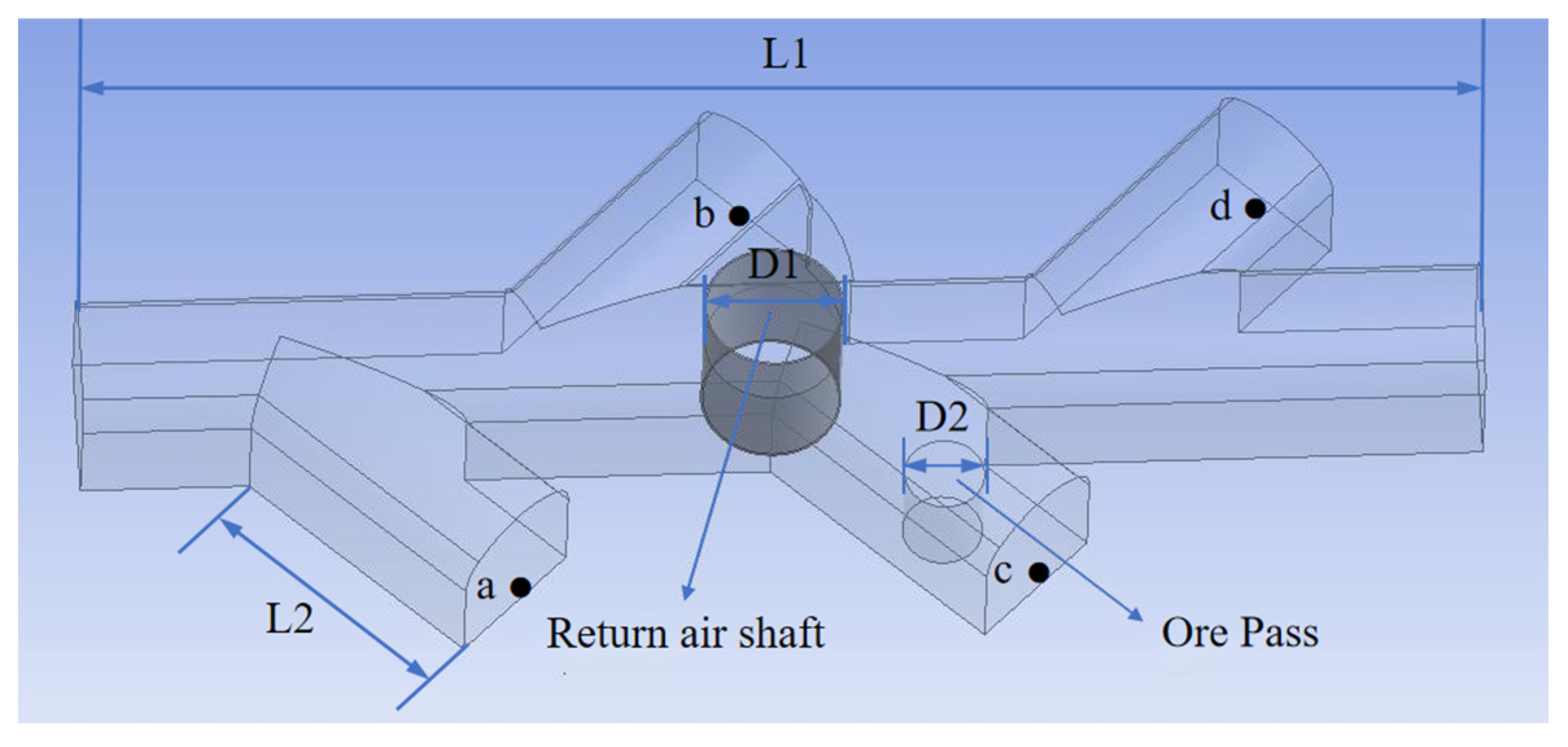
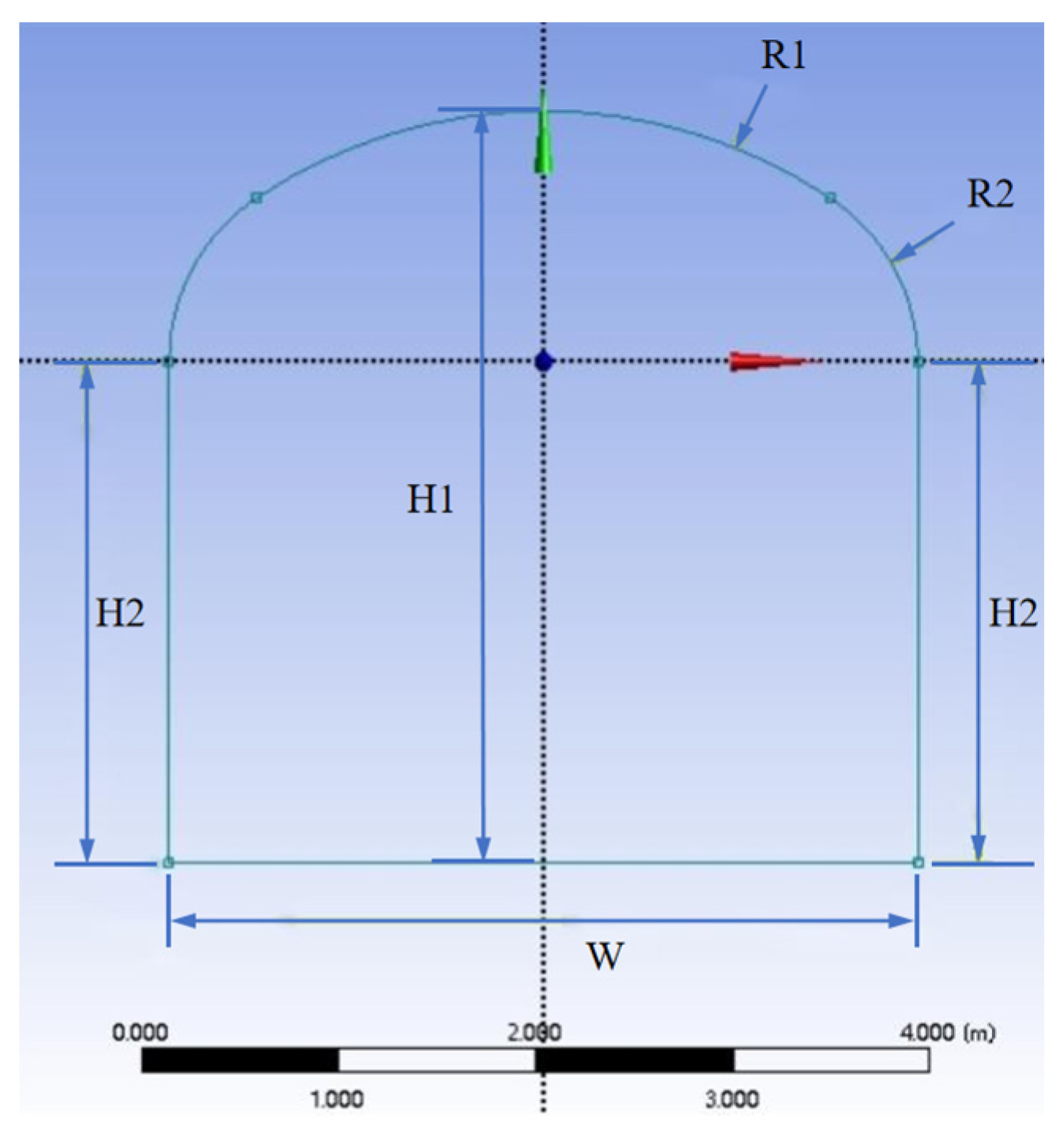

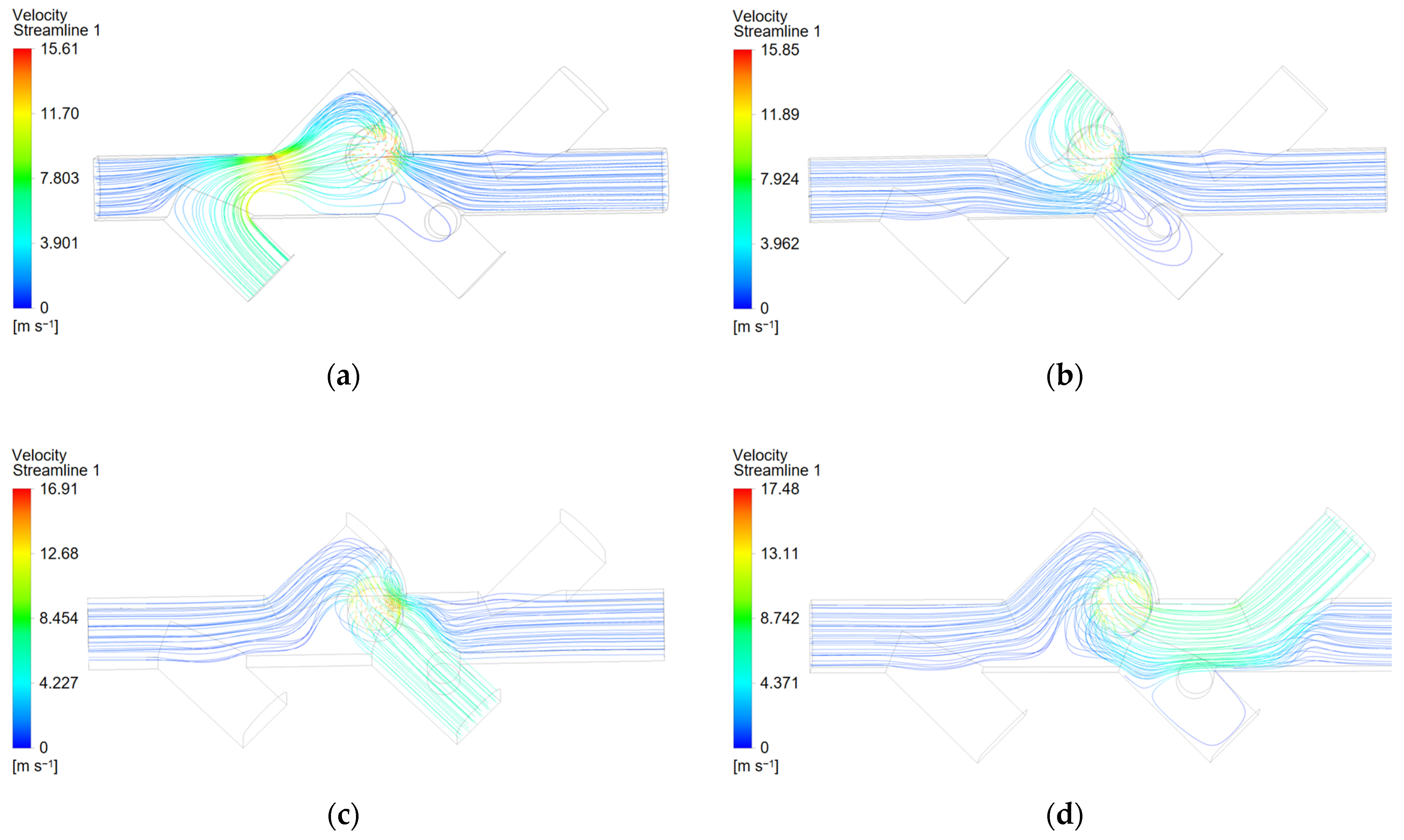
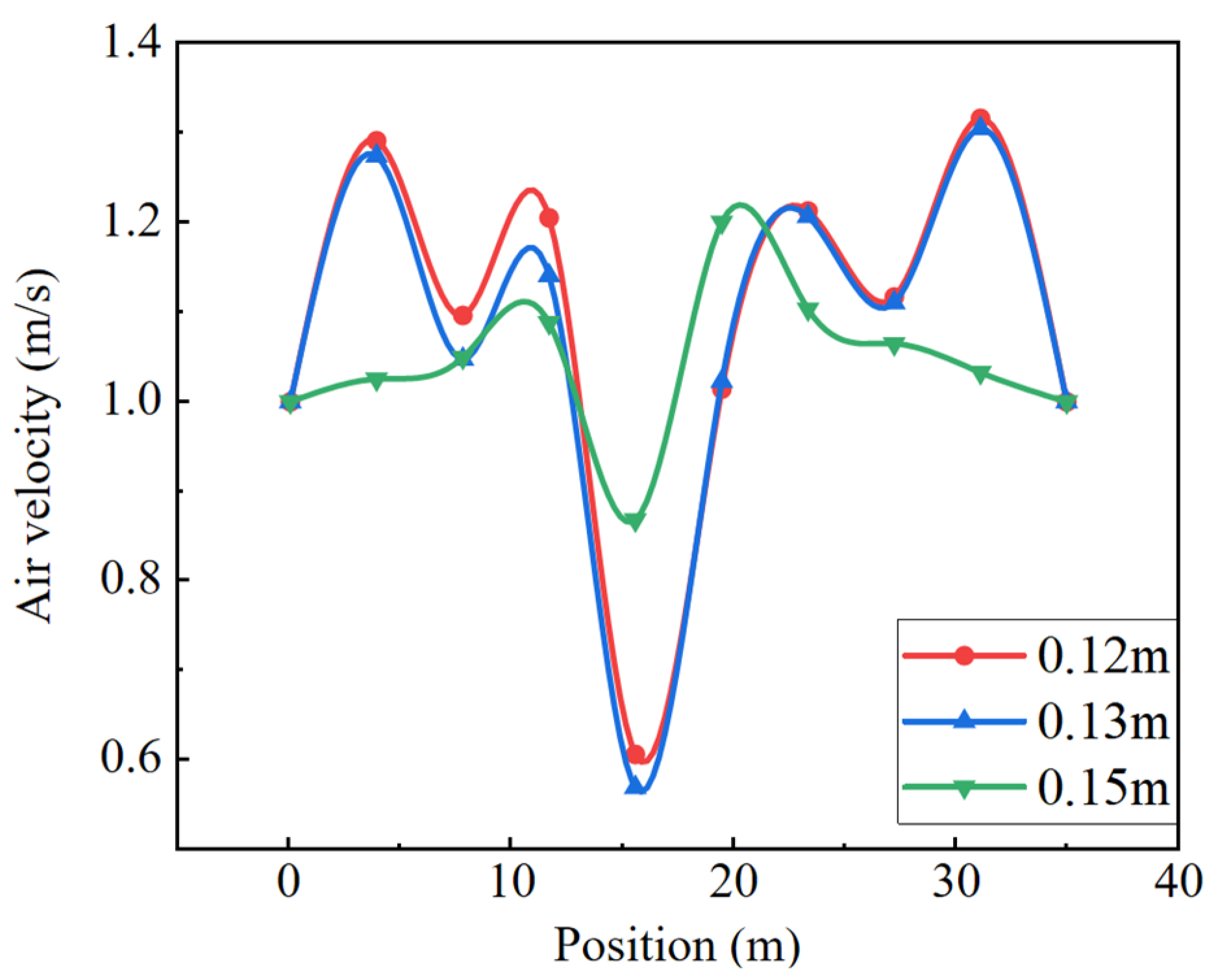
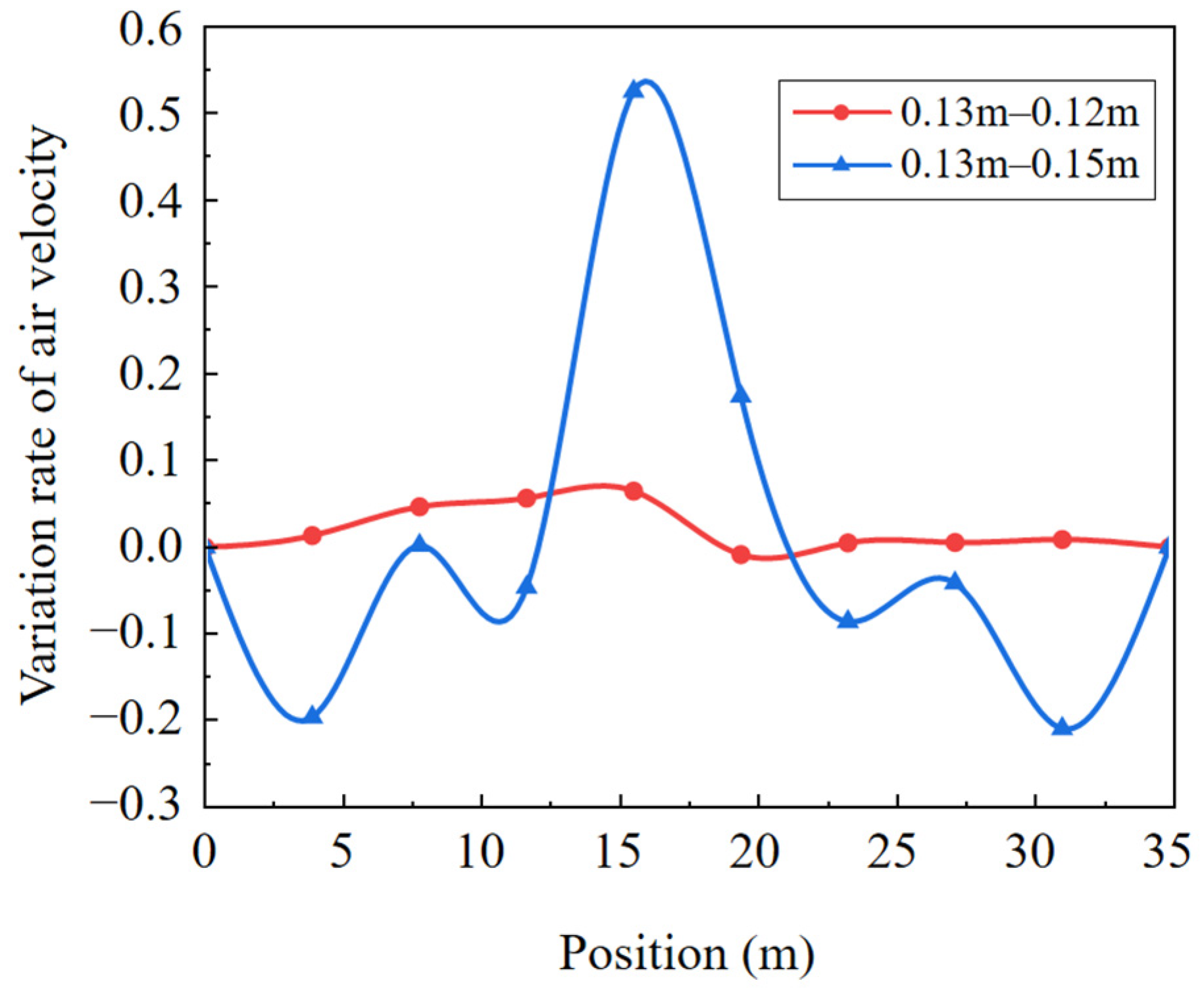

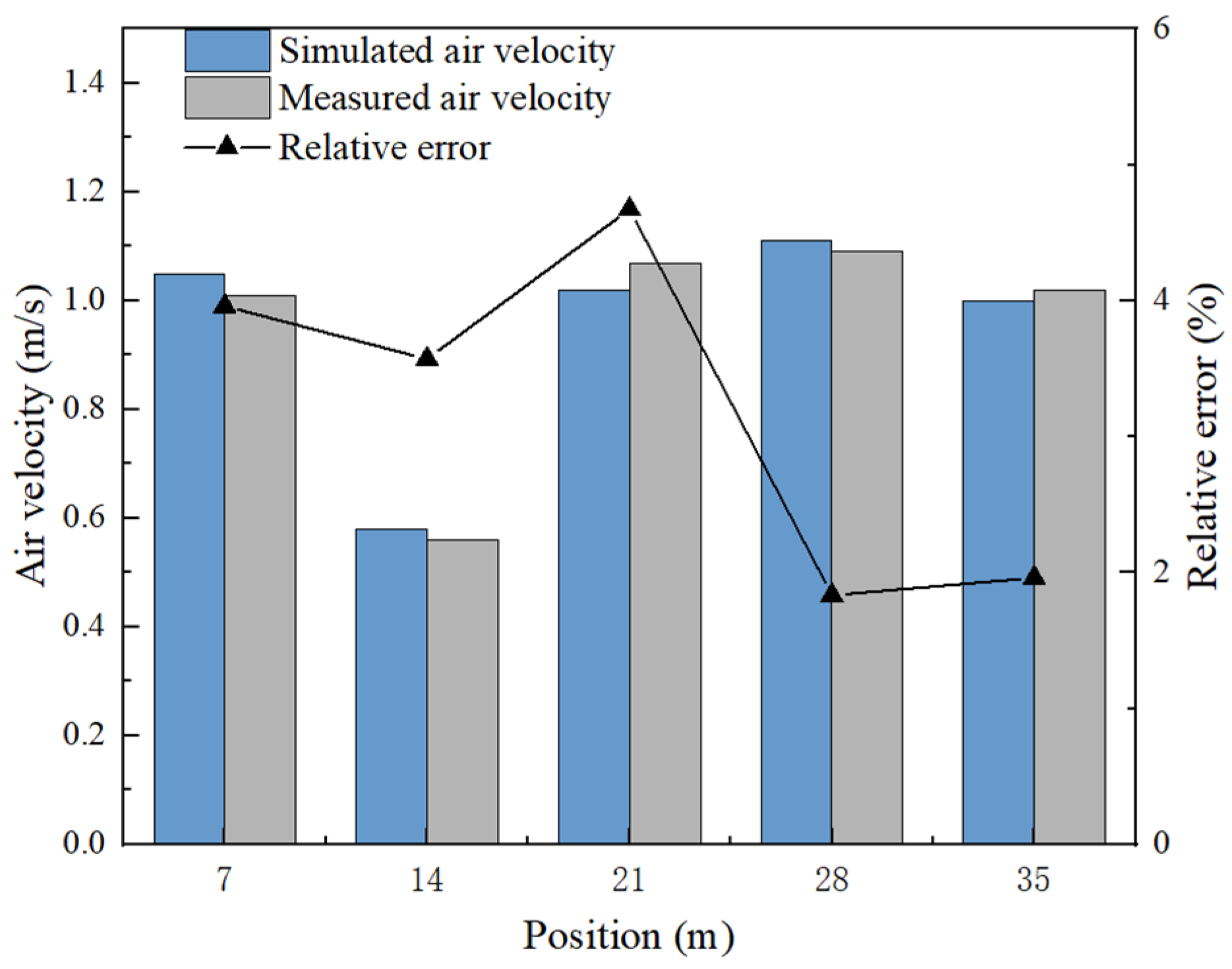
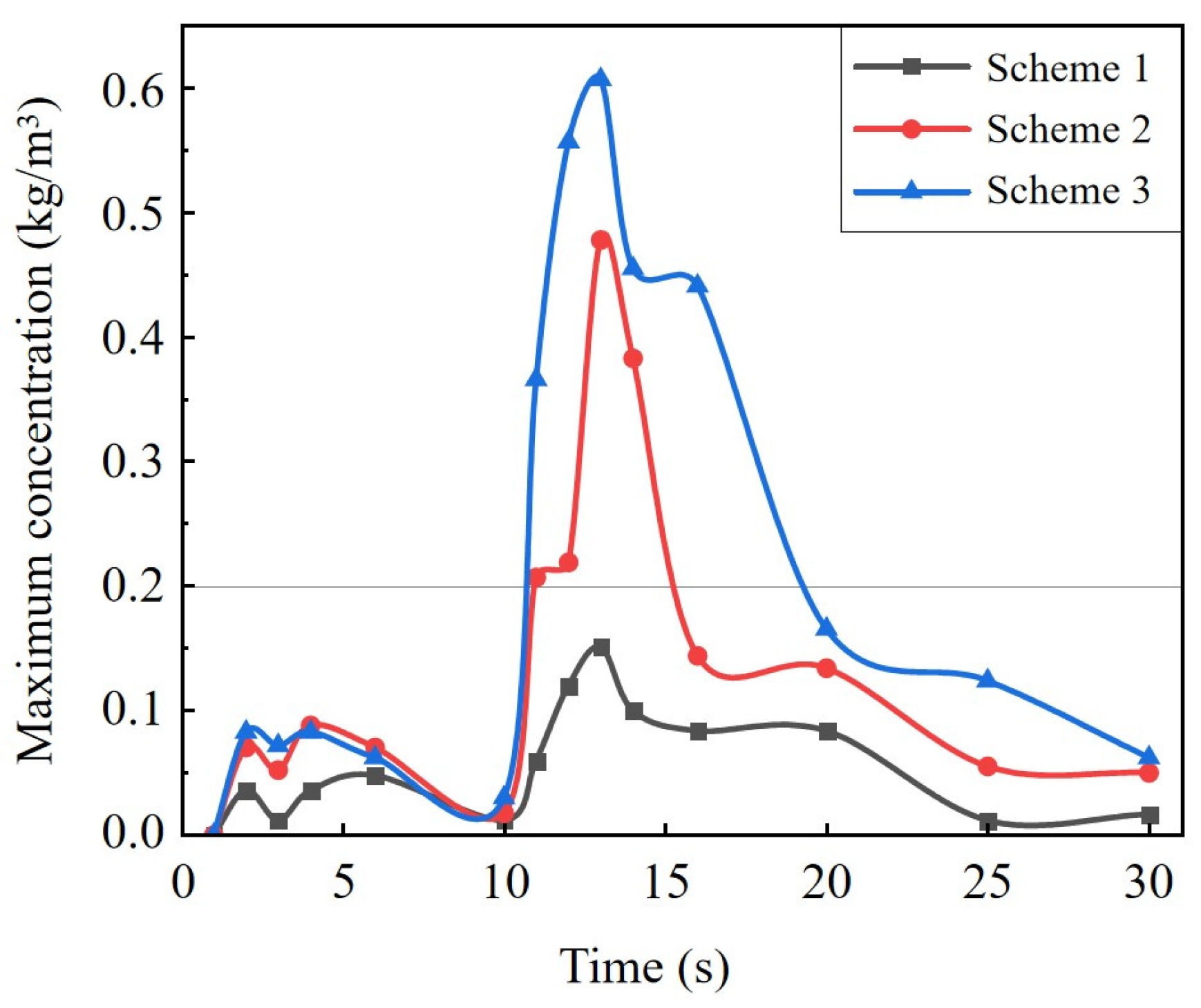
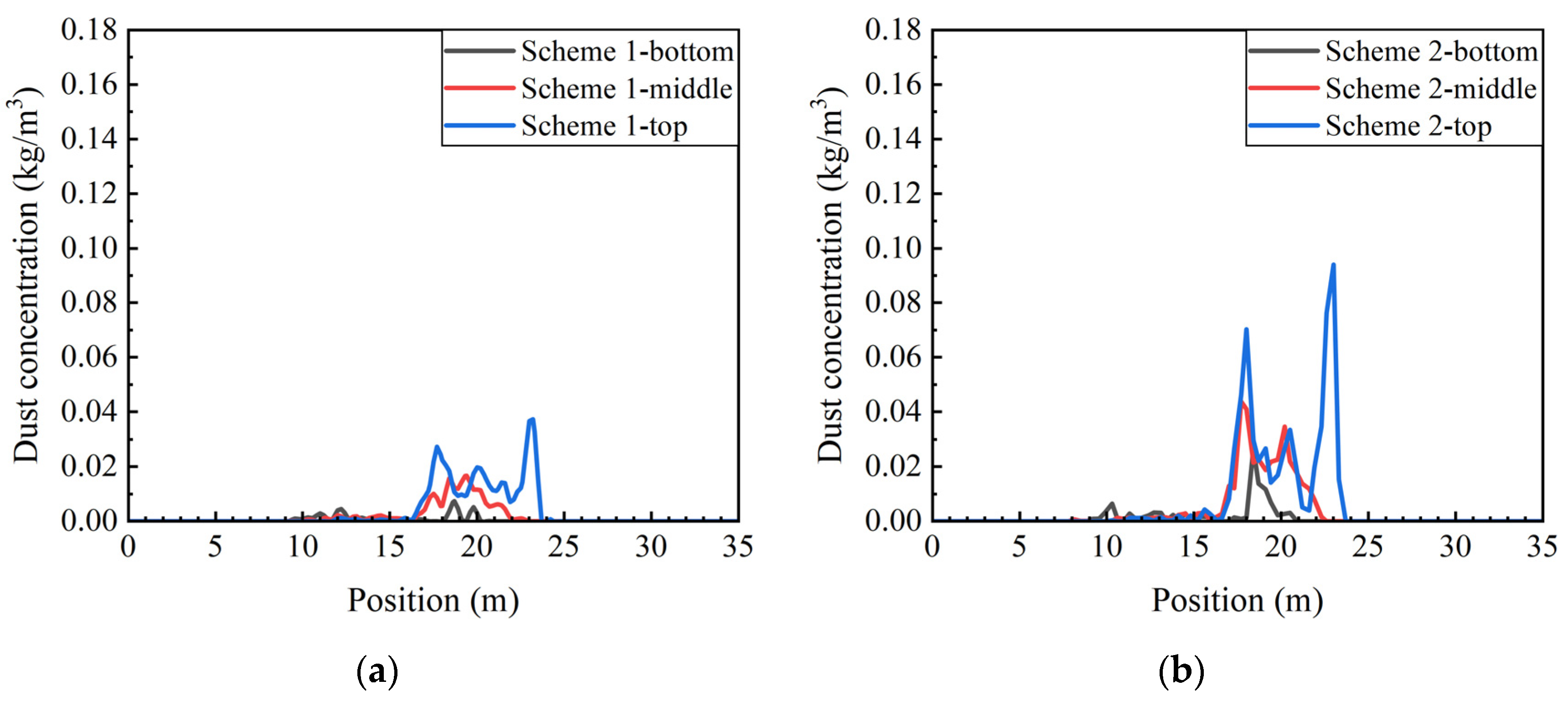
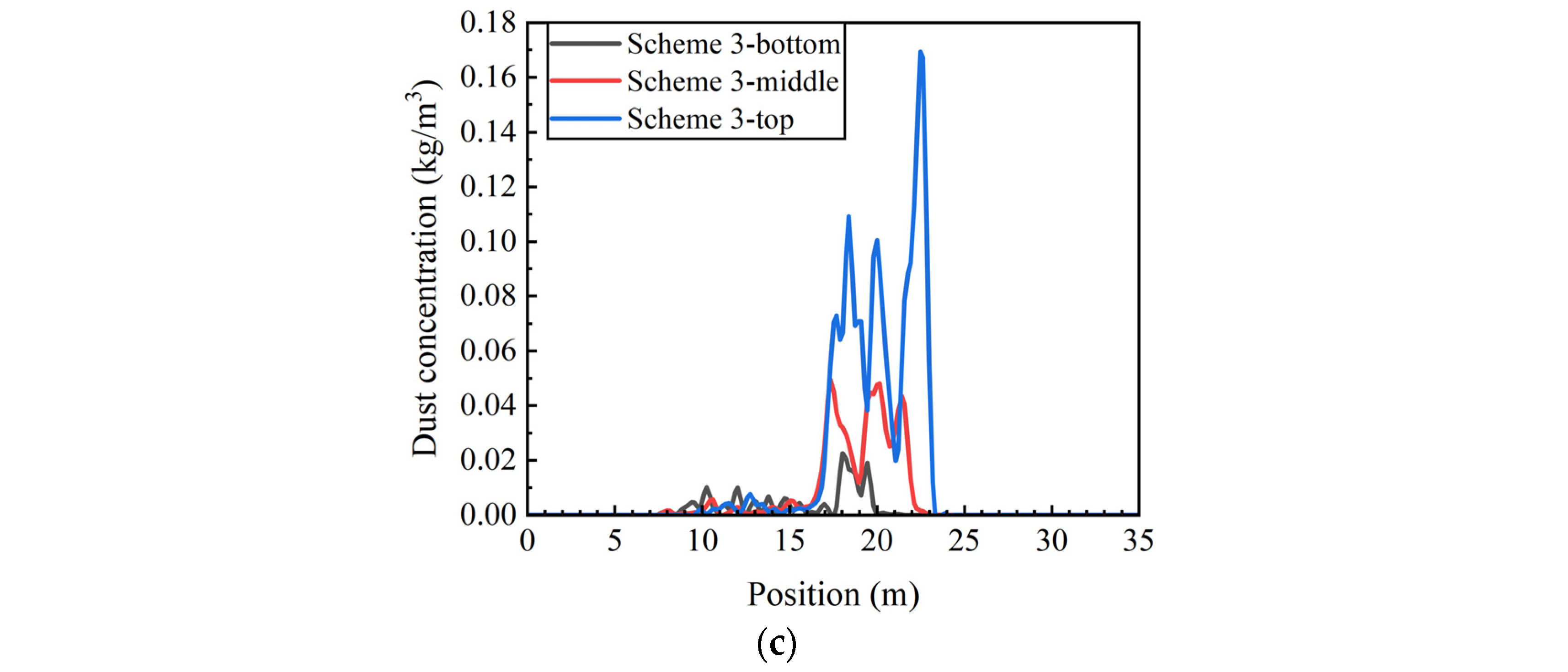
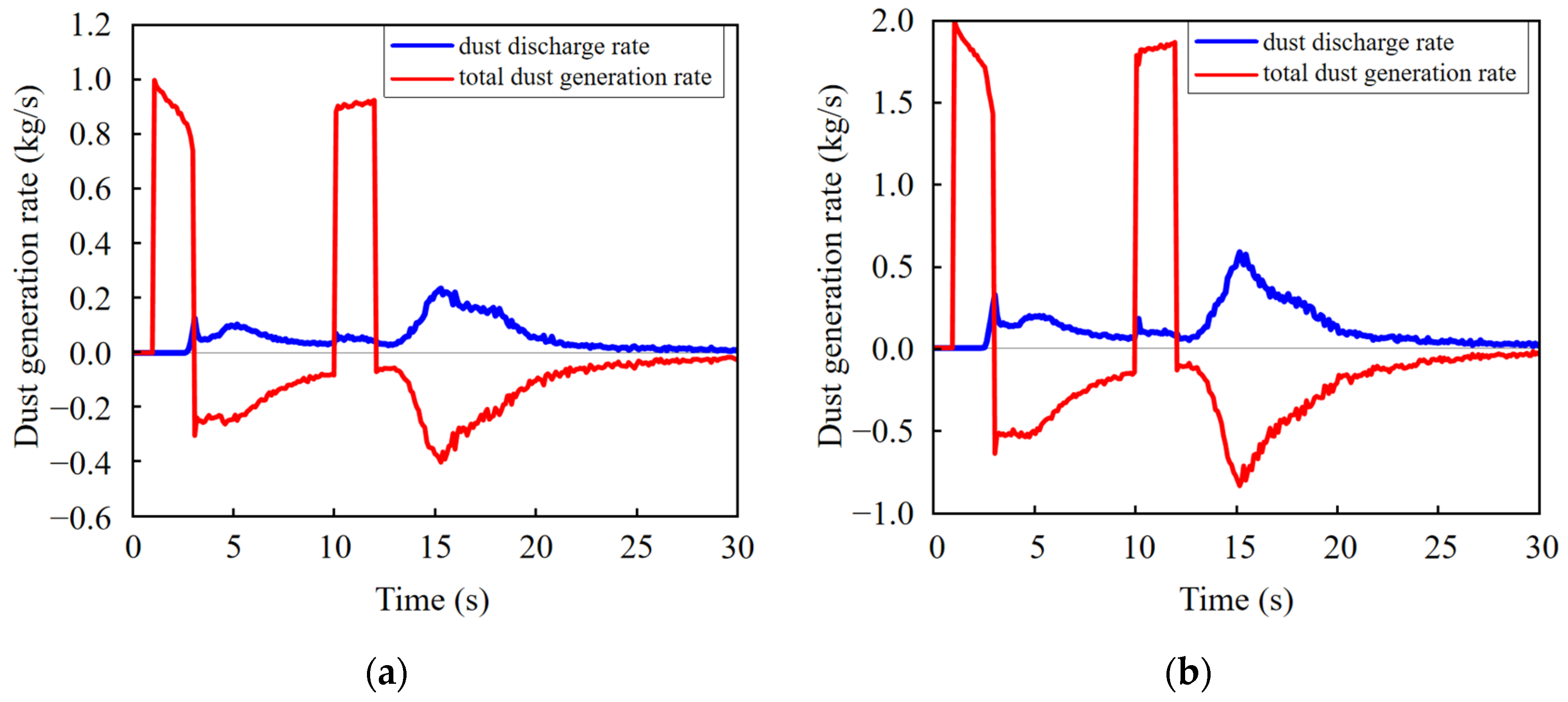
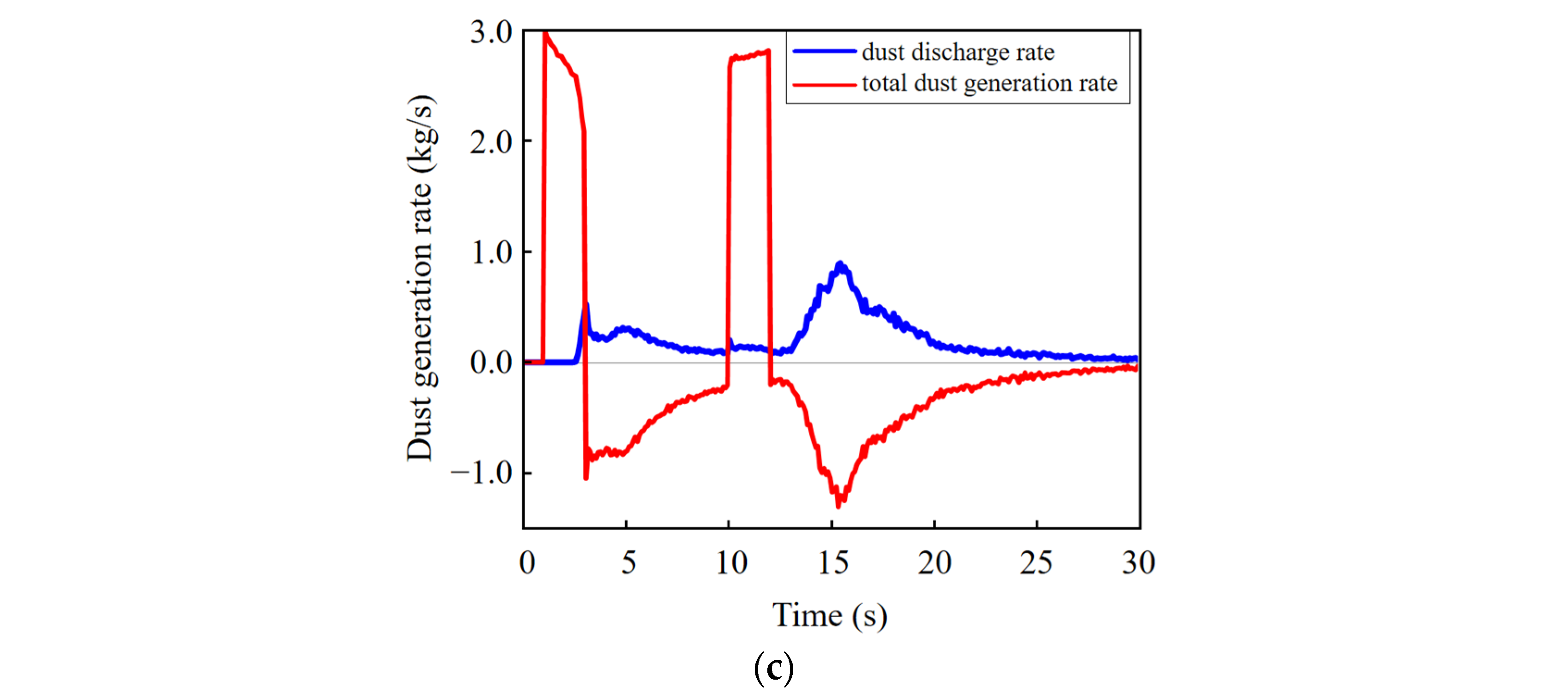
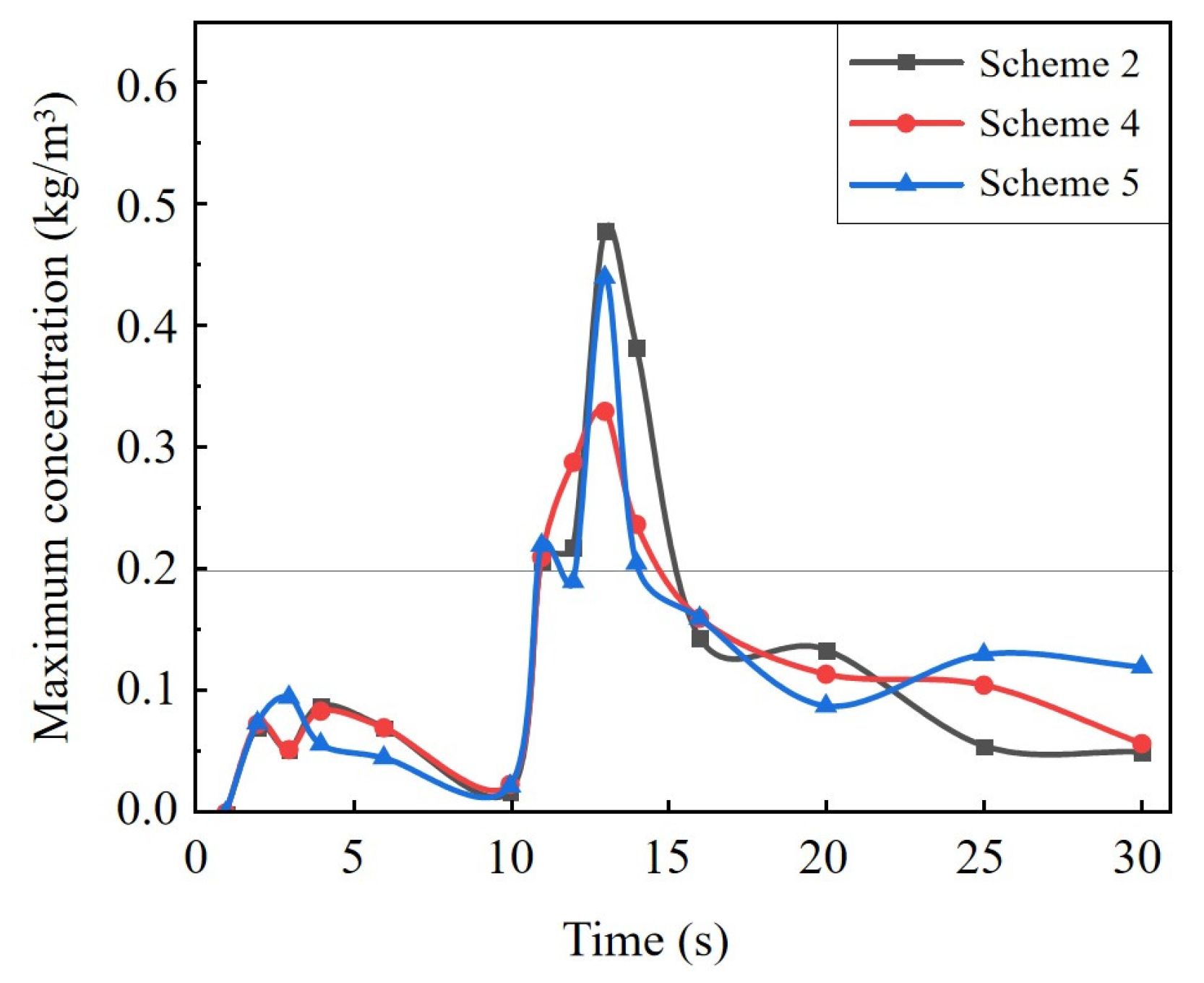
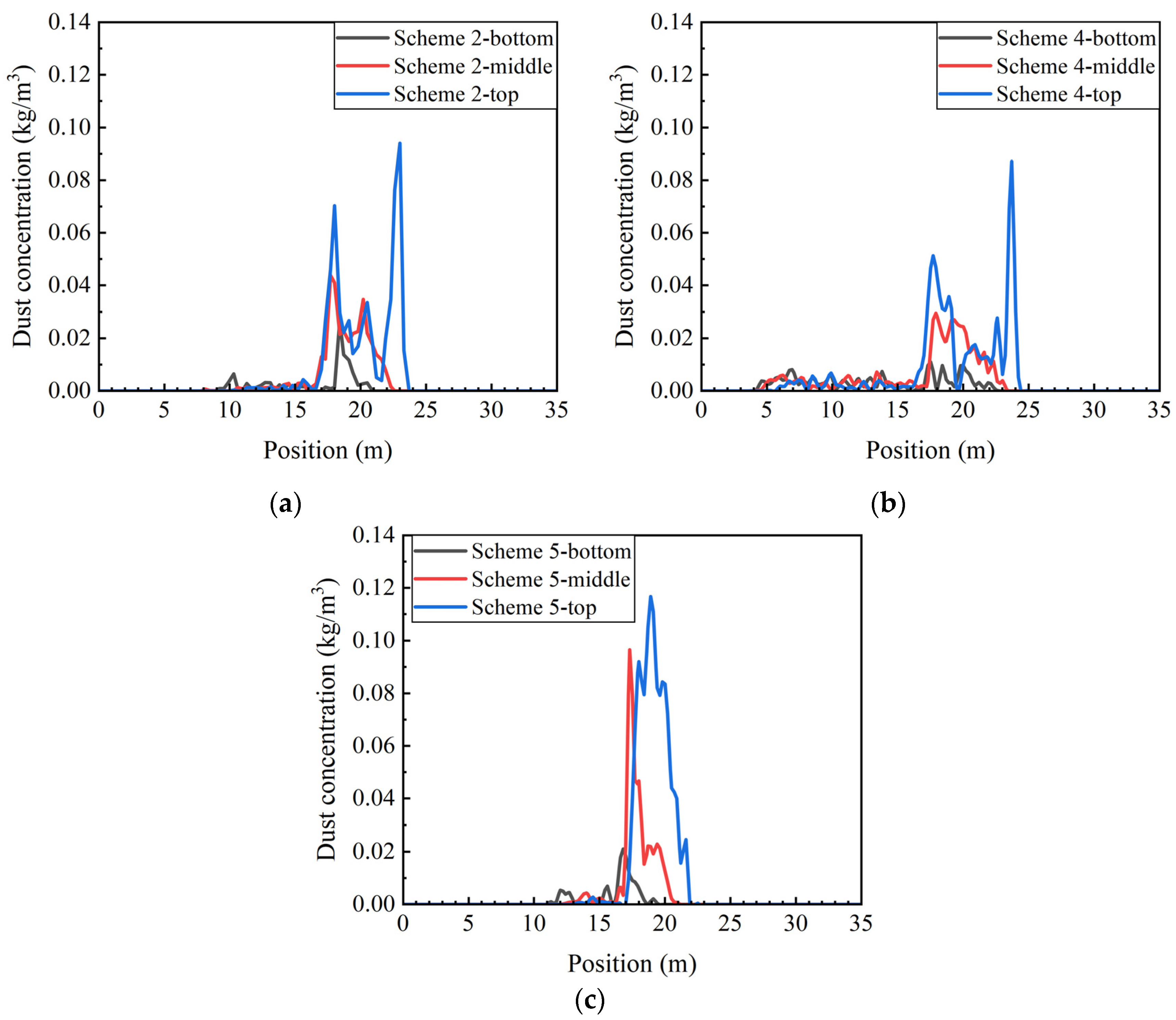
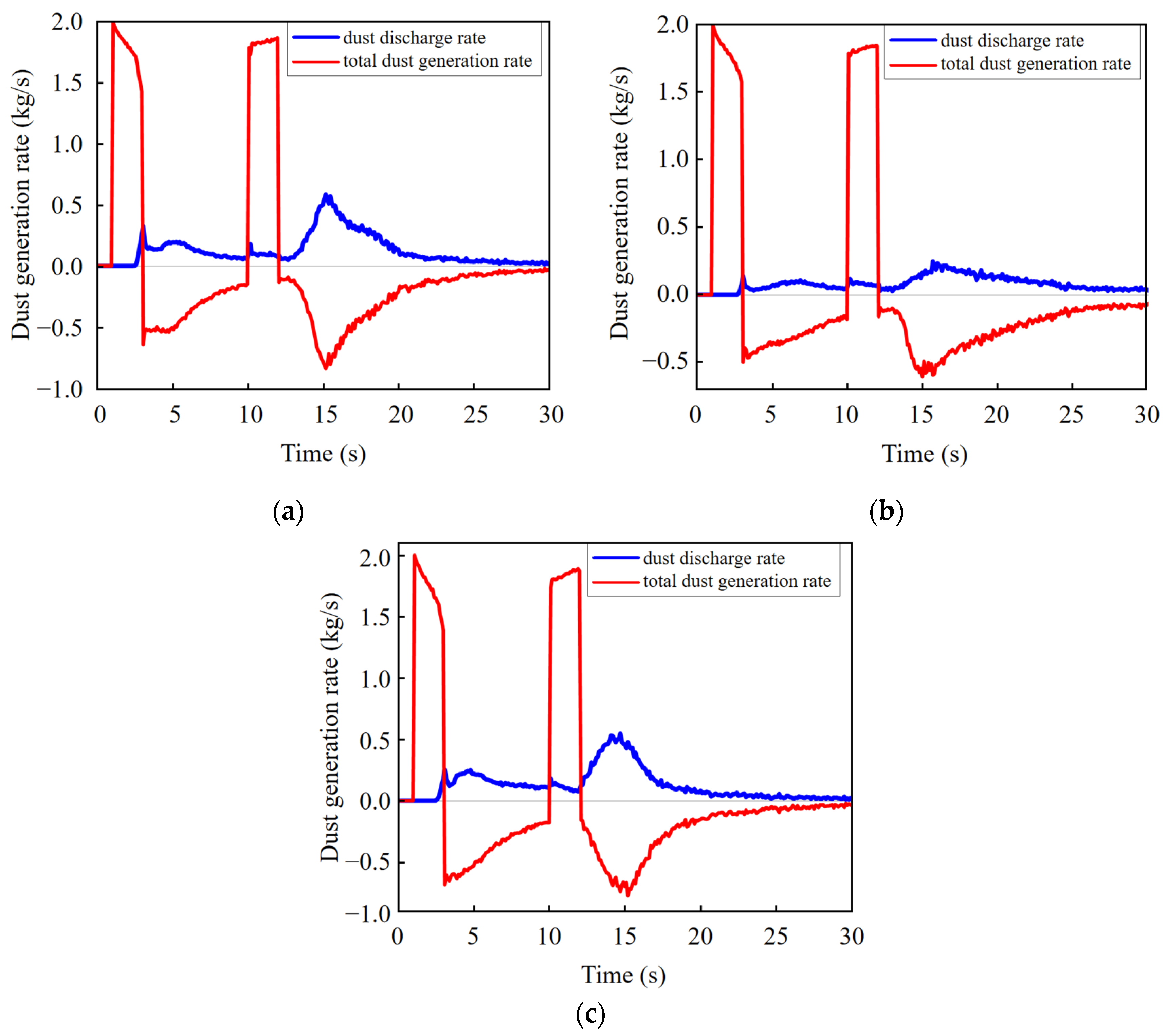
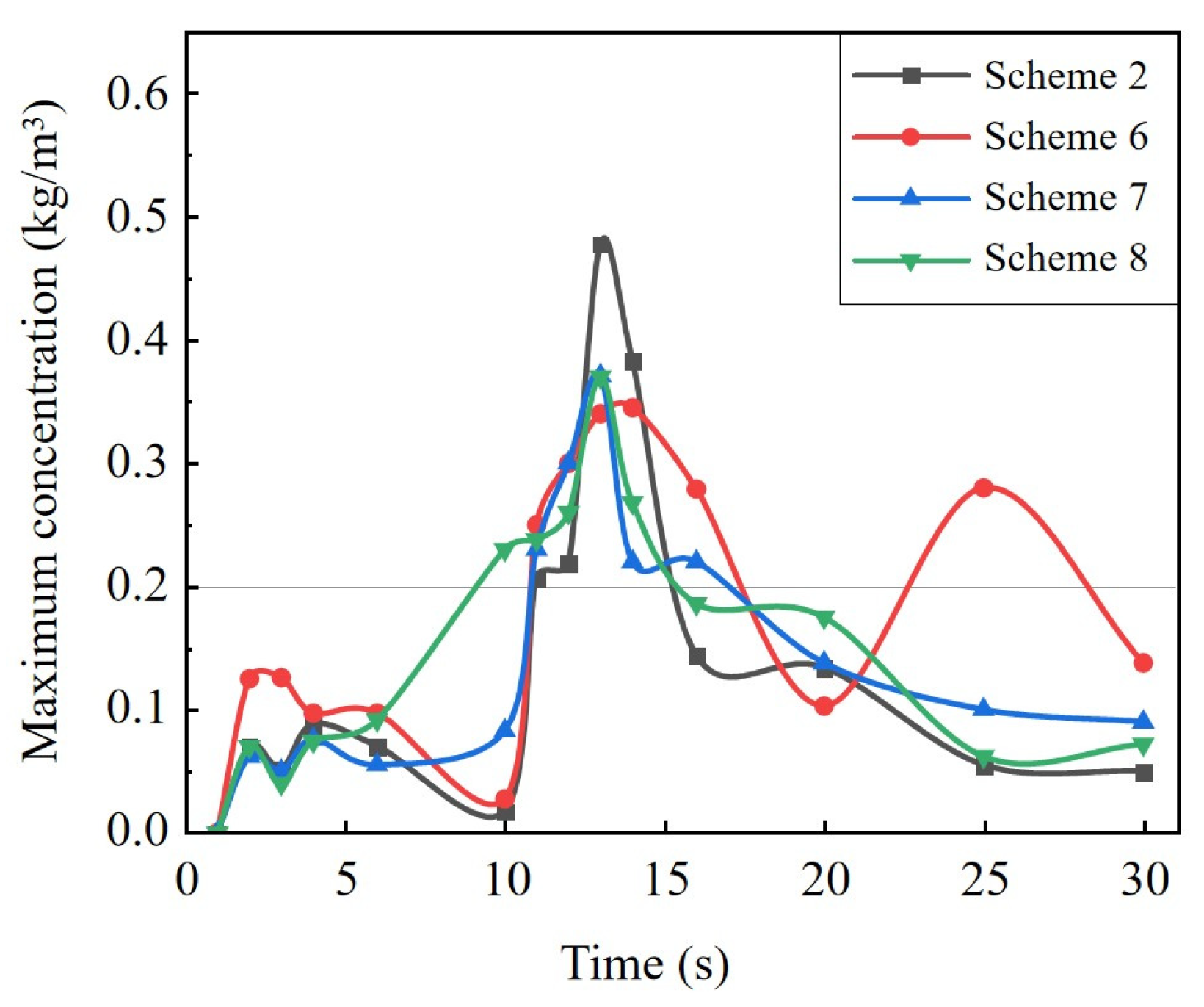
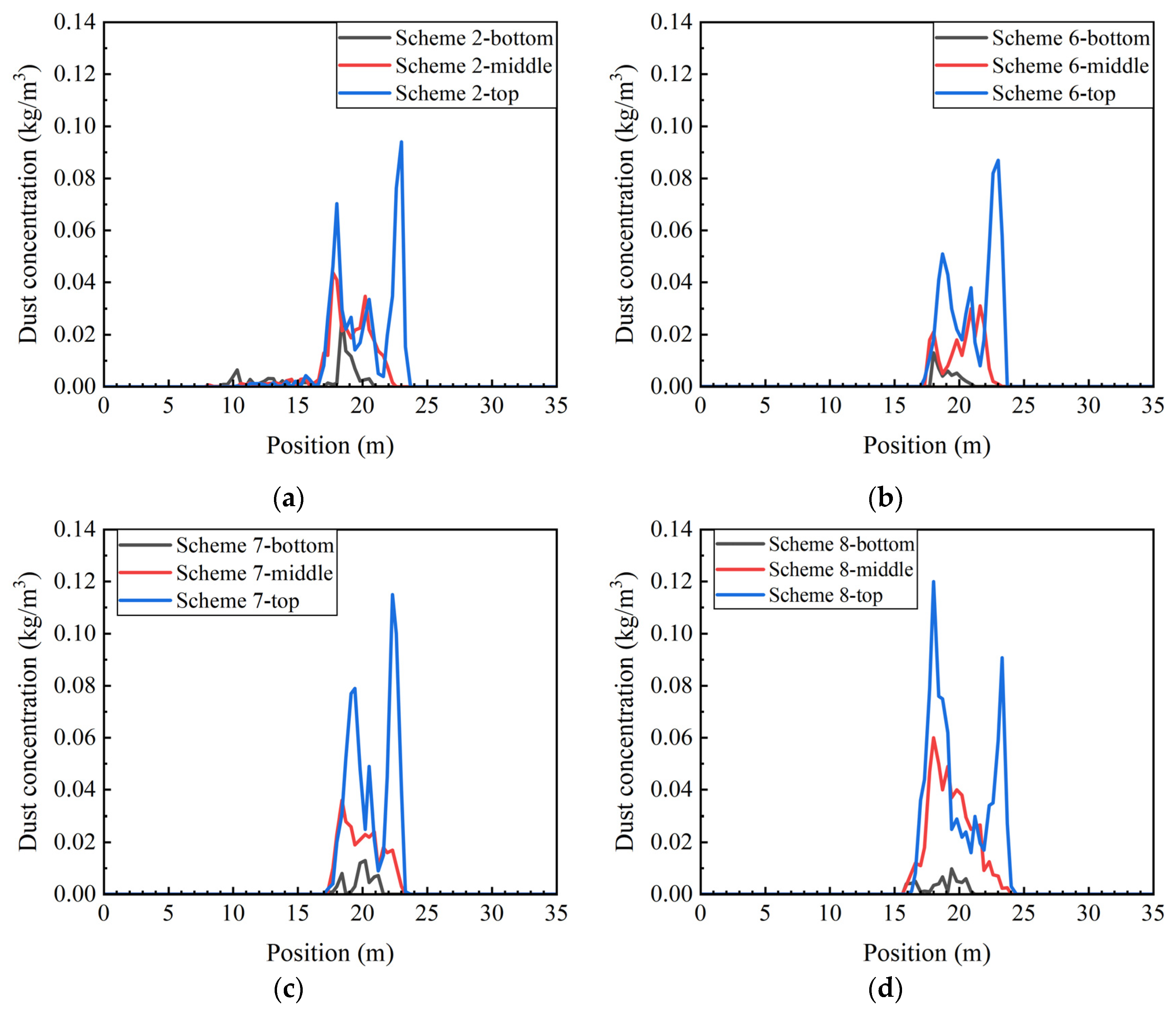
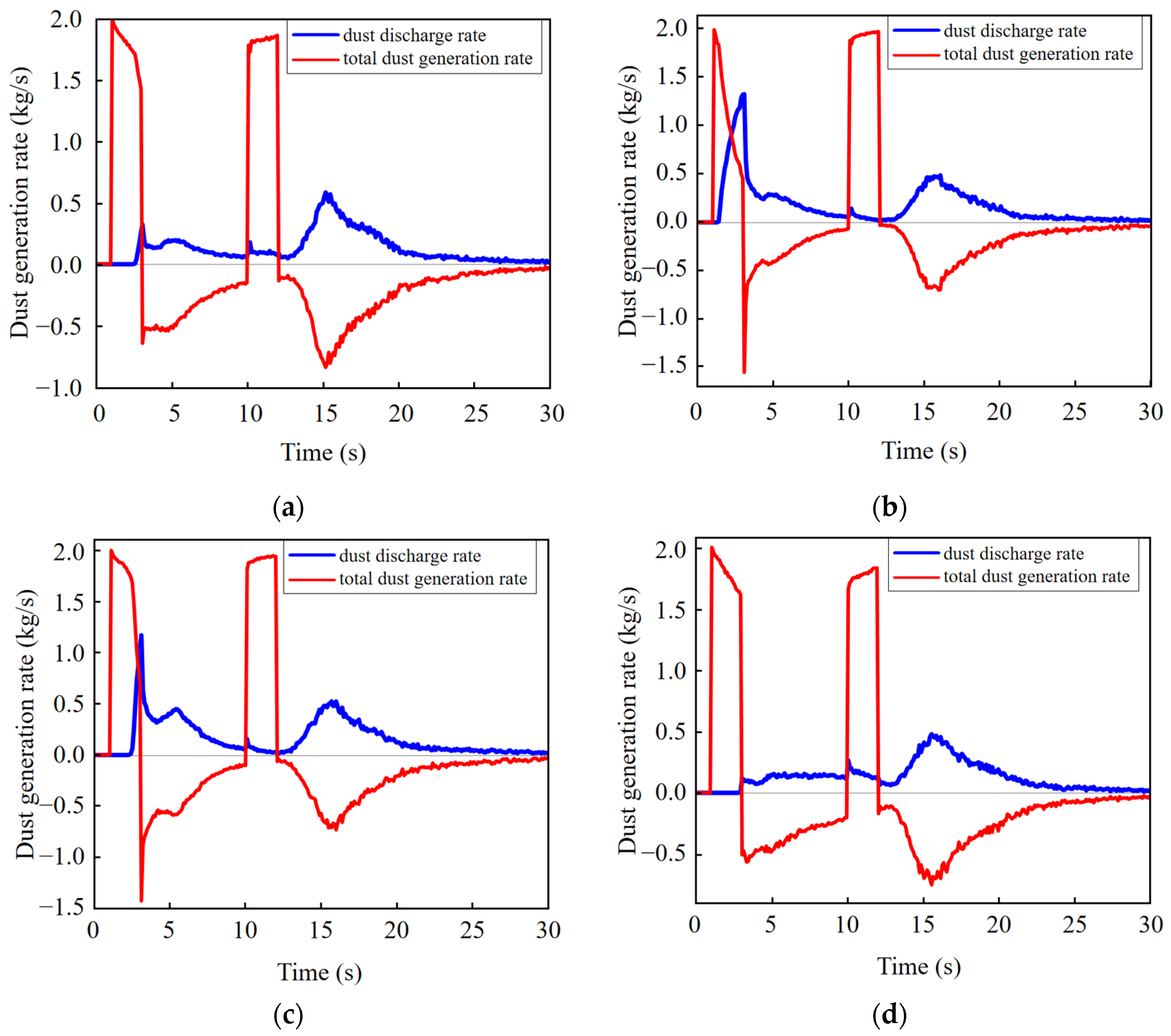
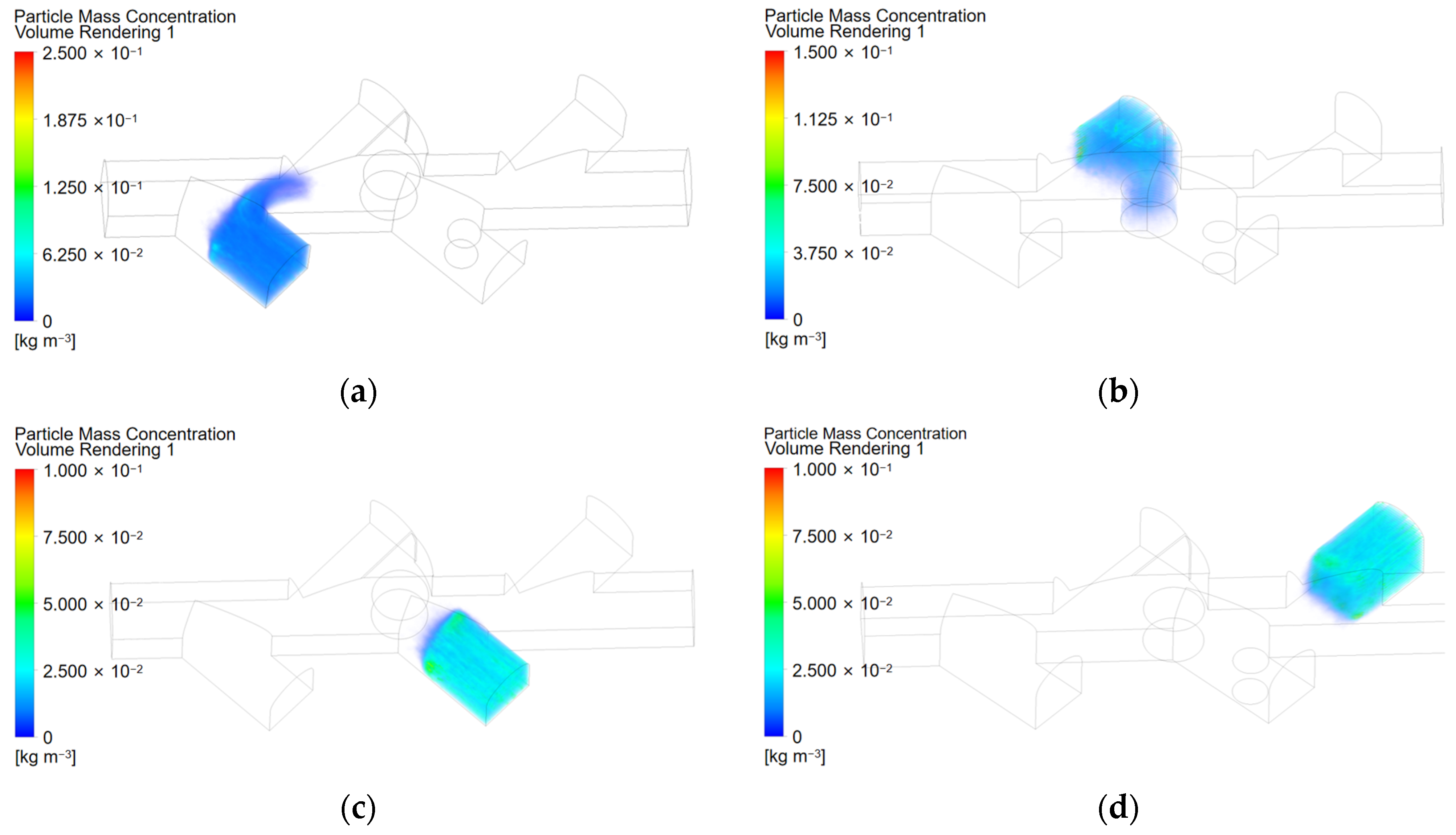

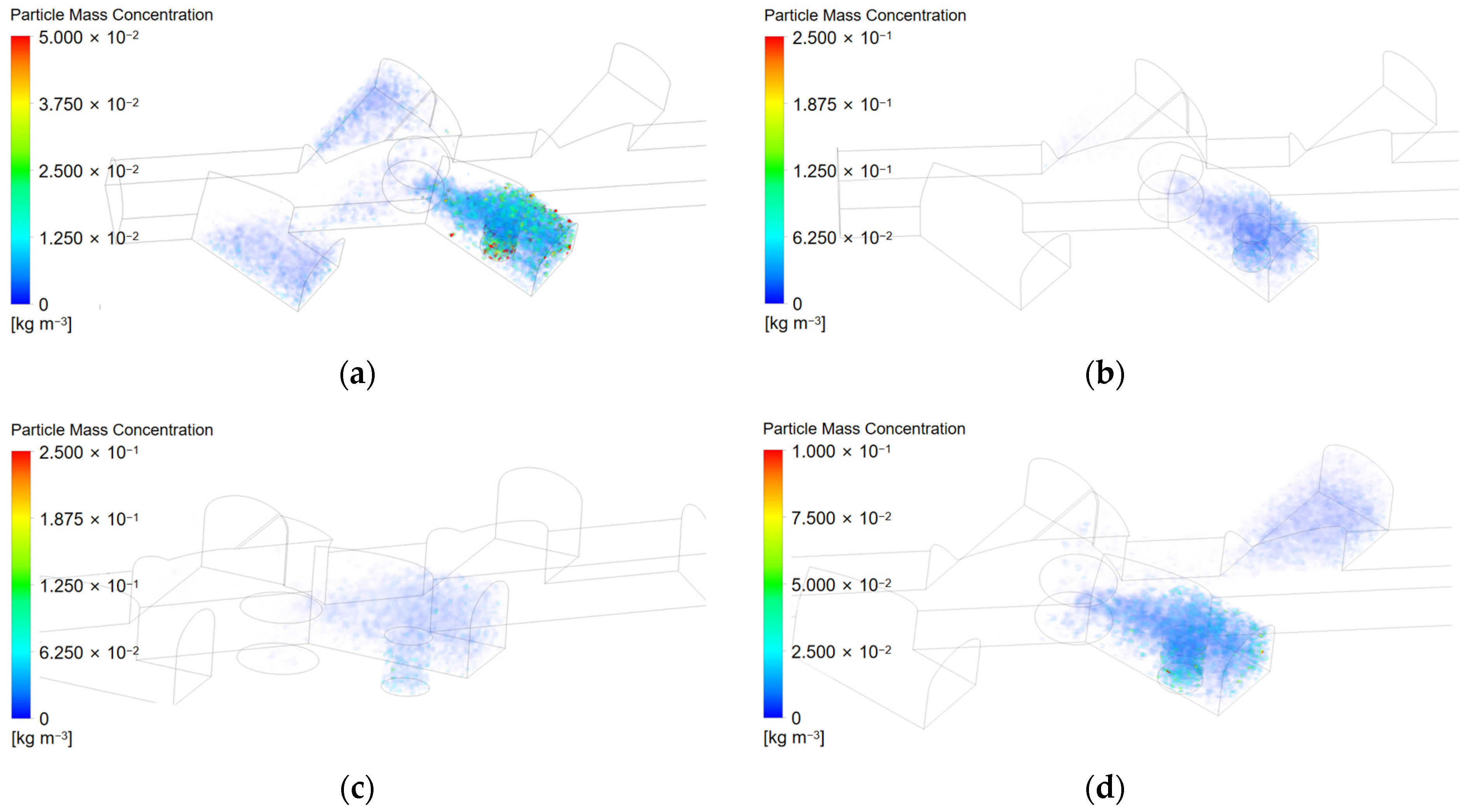
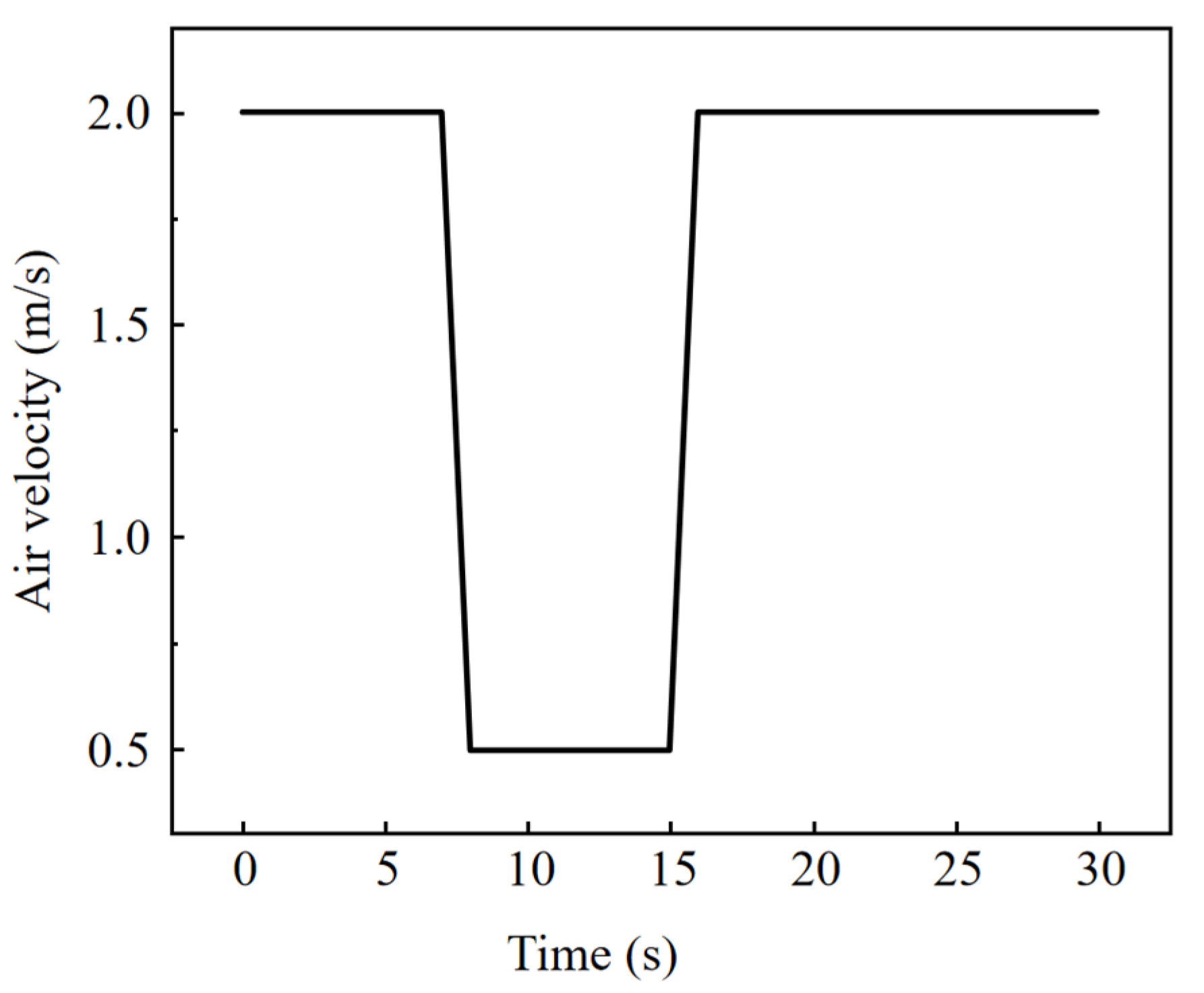

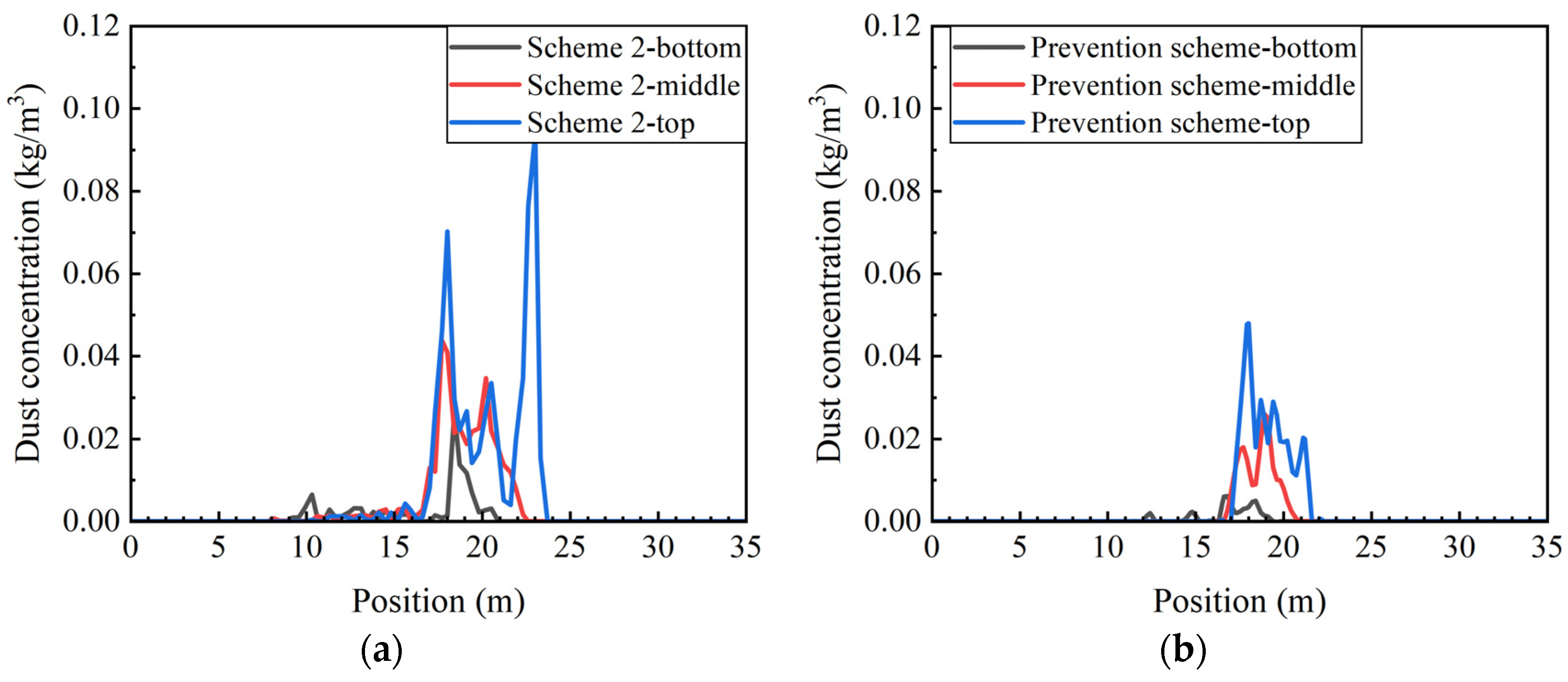

| Letter | Letter Meaning | Dimension |
|---|---|---|
| L1 | Length of main haulage roadway | 35 m |
| L2 | Length of secondary haulage roadway | 5 m |
| D1 | Diameter of return air shaft | 3.4 m |
| D2 | Diameter of ore pass | 0.7 m |
| W | Net width of roadway cross-section | 3.8 m |
| H1 | Height of roadway cross-section | 3.8 m |
| H2 | Net height of roadway cross-section | 2.53 m |
| R1 | Radius of three-centered arch | 2.63 m |
| R2 | Radius of three-centered arch | 0.88 m |
| Scheme | Grid Size (m) | Number of Grids | Number of Nodes |
|---|---|---|---|
| 1 | 0.12 | 1,689,785 | 3,437,177 |
| 2 | 0.13 | 1,409,799 | 260,782 |
| 3 | 0.15 | 1,010,232 | 187,919 |
| Parameters | Minimum | Maximum | Average |
|---|---|---|---|
| Grid quality | 0.22216 | 1 | 0.8447 |
| Aspect ratio | 1.1596 | 9.2224 | 1.8227 |
| Skewness | 7.0832 × 10−6 | 0.79979 | 0.21601 |
| Orthogonality | 0.25891 | 0.99681 | 0.86471 |
| Maximum corner | 70.653° | 157.18° | 95.542° |
| Boundary Condition | Parameter |
|---|---|
| Inlet boundary type | Velocity Inlet |
| Velocity magnitude | 6 m/s |
| Outlet boundary type | Pressure Outlet |
| Turbulence intensity | 2.72% |
| Wall roughness height | 0.05 m |
| Wall roughness constant | 0.6 |
| Upper and side wall | Reflect |
| Bottom wall | Trap |
| The ends of the roadway, the ore pass, and the bottom of the return air shaft | Escape |
| Hydraulic diameter | 3.84 |
| Reynolds number | 1,462,174 |
| Turbulence intensity | 2.71% |
| Wall shear condition | No-Slip |
| Discrete Phase Model | Parameter |
|---|---|
| Interaction with Continuous Phase | On |
| Update DPM source each flow iteration | On |
| Unsteady particle tracking | On |
| Maximum steps | 2000 |
| Length scale | 0.01 m |
| Discrete random walk model | On |
| Injection type | Surface |
| Material | Copper Ore |
| Density | 4200 kg/m3 |
| Diameter distribution | Roisin–Rammler |
| Min. Diameter | 1 × 10−6 m |
| Max. Diameter | 1 × 10−4 m |
| Spread parameter | 1.87 |
| Continuous Phase Model | Parameter |
|---|---|
| Solver | Pressure Based |
| Time | Steady |
| Viscous Model | Realizable k-ε |
| Near-wall Treatment | Standard Wall Functions |
| Energy | Off |
| Temperature | 25 °C |
| Material | Air |
| Density | 1.1691 kg/m3 |
| Viscosity | 1.84 × 10−5 kg/m·s |
| Solution methods | Parameter |
| Pressure–Velocity Coupling | Simple |
| Momentum Discretization | First order upwind |
| Convergence criterion | 10−4 |
| Time step size | 0.1 s |
| Number of Time steps | 300 |
| Maximum iteration steps | 40 |
| Calculation steps | 12,000 |
| Simulation Scheme | Dust Source Position (Ore Loading Point) | Dust Generation Rate in the First Dust Generation Stage (kg/s) | Dust Generation Rate in the Second Dust Generation Stage (kg/s) | Air Velocity in the Road with Dust Source Position (m/s) |
|---|---|---|---|---|
| 1 | a | 1 | 1 | 1 |
| 2 | a | 2 | 2 | 1 |
| 3 | a | 3 | 3 | 1 |
| 4 | a | 2 | 2 | 0.5 |
| 5 | a | 2 | 2 | 2 |
| 6 | b | 2 | 2 | 1 |
| 7 | c | 2 | 2 | 1 |
| 8 | d | 2 | 2 | 1 |
Disclaimer/Publisher’s Note: The statements, opinions and data contained in all publications are solely those of the individual author(s) and contributor(s) and not of MDPI and/or the editor(s). MDPI and/or the editor(s) disclaim responsibility for any injury to people or property resulting from any ideas, methods, instructions or products referred to in the content. |
© 2024 by the authors. Licensee MDPI, Basel, Switzerland. This article is an open access article distributed under the terms and conditions of the Creative Commons Attribution (CC BY) license (https://creativecommons.org/licenses/by/4.0/).
Share and Cite
Li, Z.; Hu, P.; Xu, Y. Study on Sulfide Ore Dust Dispersion and Dust Reduction Measures Based on Simulation. Minerals 2024, 14, 523. https://doi.org/10.3390/min14050523
Li Z, Hu P, Xu Y. Study on Sulfide Ore Dust Dispersion and Dust Reduction Measures Based on Simulation. Minerals. 2024; 14(5):523. https://doi.org/10.3390/min14050523
Chicago/Turabian StyleLi, Zijun, Pengyu Hu, and Yuanyuan Xu. 2024. "Study on Sulfide Ore Dust Dispersion and Dust Reduction Measures Based on Simulation" Minerals 14, no. 5: 523. https://doi.org/10.3390/min14050523
APA StyleLi, Z., Hu, P., & Xu, Y. (2024). Study on Sulfide Ore Dust Dispersion and Dust Reduction Measures Based on Simulation. Minerals, 14(5), 523. https://doi.org/10.3390/min14050523






